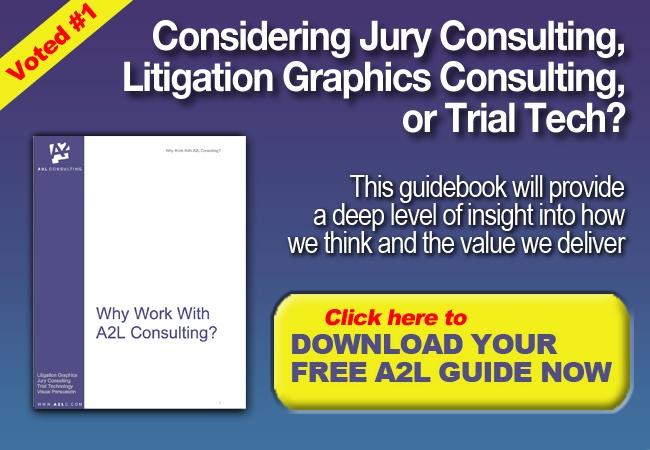Source of article The Litigation Consulting Report (A2L Consulting).
It is unquestioned that technology has had a profound impact on our environment in the last couple of decades. Our brains are constantly adapting at a physical level to our environment, and research has suggested that technology has changed the way we perceive, remember, and process information. Not much has yet been said, however, about how technology has changed the ways in which jurors process information and the appropriate new styles that trial lawyers ought to use in presenting information to a jury.
The growth of the internet, 24-hour television, and mobile phones means that we now receive five times as much information every day as we did 30 years ago. With the appropriate internet connection, technology allows us to access any information in less than a second. According to Internet Live Stats (2014), 88.5 percent of people in the United States are internet users. In addition, the internet has also changed the way we as a society process information.
For example, when we read a book we do so linearly, from one sentence to another, but when using multimedia devices, we scan for keywords and grab small bits of relevant information. The internet has influenced people’s cognition in a way which they will now typically forego complex analytic thinking to get information quickly and easily. In other words, people allow the internet or even their smartphones think for them.
As a result, it is much harder to sustain attention, to think about one thing for an extended period, and to think deeply when new stimuli have been pouring in all day long. This is not to say that technology has negatively impacted our brain. Instead, the excess amount of information at our fingertips has changed the way we process large amounts of information and specifically, what information engages our attention.
For these reasons, pictures that are presented with technology are assuming more power in the learning process, especially with the millennial generation. The dominance of visual media in everything from Instagram to online news articles has given words less status. Consultant Marc Prensky, who invented the term “digital native,” argues that in previous generations, graphics were illustrations, accompanying the text and providing elucidation. For today’s generation, the relationship is almost entirely reversed: the role of text is to elucidate something that was first experienced as an image.
A paper by Jaihyun Park and Neal Feigenson is one of several that supports Prensky’s assertion. The article discusses two studies explored the effects of lawyers’ use of PowerPoint on liability judgments in a case involving statistical evidence. The PowerPoints included the displays of graphs and charts to explain the statistical evidence and modest animations to enhance visual contrasts. The studies compared opening arguments delivered with and without simple PowerPoint visuals.
When PowerPoint with graphics was used, the researchers found that jurors were able to recall details about statistical evidence correctly. When PowerPoint was not used, jurors remembered the statistical evidence less accurately. The researchers also concluded that their study was similar to findings of another study of the effects of computer animations on mock juror decision-making, conducted by Feigenson with Meghan A. Dunn and Peter Salovey in 2006.
The findings from the 2006 study showed that the percentage of participants who rendered a verdict for the plaintiff in a vehicular accident case was significantly greater when the plaintiff’s lawyer used an animation and the defendant’s lawyer used only a still diagram.
As the internet becomes even more pervasive in our lives, the lesson should not be lost on trial lawyers: The visual has surpassed the verbal as a means of persuasion. Jurors are expecting to see graphics, and that is what lawyers should show them.
Other Free A2L Articles about litigation graphics, persuasion, and the need for using visuals at trial include:
- 5 Ways to Maximize Persuasion During Opening Statements – Part 4
- Still Think Persuasion is About Talking While Showing Bullet Points?
- 9 Things That Define the Best Litigation Graphics
- 12 Reasons Litigation Graphics are More Complicated Than You Think
- Litigation Graphics: It’s Not a Beauty Contest
- 11 Ways to Start Right With Your Litigation Graphics Team
- FREE DOWNLOAD: Storytelling for Litigators: Building a Great Narrative for Judge & Jury
- FREE WEBINAR: Storytelling as a Persuasion Tool
- 17 Reasons Why Litigation Consultants Are Better at Graphics Than Law Firms
- FREE DOWNLOAD: Complimentary Complex Civil Litigation E-Book Download
- FREE DOWNLOAD: A Litigator’s Guide: How To Find and Use Trial Technicians and Trial Technology
- 21 Reasons a Litigator Is Your Best Litigation Graphics Consultant
- My Case Is Not Visual – So Why Do I Need Litigation Graphics?
- FREE DOWNLOAD: Using & Creating Litigation Graphics to Persuade – An E-Book for Litigators and Litigation Support Professionals
- 12 Ways to SUCCESSFULLY Combine Oral and Visual Presentations
- 16 PowerPoint Litigation Graphics You Won’t Believe Are PowerPoint
- The 14 Most Preventable Trial Preparation Mistakes
- Why Litigation Graphics at Mock Trials Make Sense
- Law360 Interviews A2L Consulting’s Founder/CEO Ken Lopez
![]()

